±Ê°ù±ð²õ±ð²Ô³Ù²¹³¦¾±¨®²Ô³å±õ²Ô²µ±ô¨¦²õ³å20240814³å201633³å0000.±è»å´Ú
0 likes52 views
iwkwldnwldlwldklxlwd
1 of 8
Download to read offline
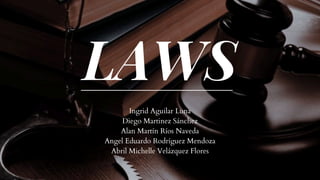
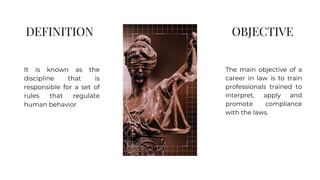
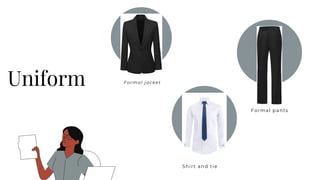

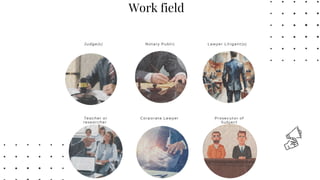

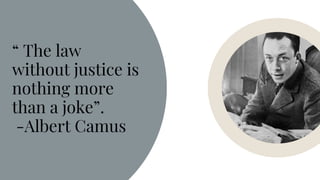

Ad
Recommended
Legal education
Legal educationAbdulrahman Subih
?
Legal education aims to teach law as an academic discipline while also preparing students for legal practice. In the US, law degrees include the Juris Doctor (JD), Master of Laws (LLM), and Doctor of Juridical Science. The JD is the standard law degree requiring a bachelor's and involving core and elective courses. The LLM is a graduate degree for those with a JD specializing in areas like human rights. The Doctor of Juridical Science is for experienced attorneys and takes three years. Legal education in India is overseen by the Bar Council of India and involves undergraduate, graduate, and postgraduate degrees in law. The objectives of legal education are to teach legal history and rules, provide experience applying rules,AN INTRODUCTION TO LEGAL STUDIES _.pptx
AN INTRODUCTION TO LEGAL STUDIES _.pptxakmcokerachita
?
Legal studies is an academic field focused on understanding law's meaning, practice, and significance. It offers various career opportunities beyond becoming a lawyer and equips students with critical thinking, analytical skills, and a deep understanding of rights and responsibilities. Legal education also fosters respect and can empower individuals to make societal changes while providing financial stability.Top Career Opportunities in Law
Top Career Opportunities in LawREVA University
?
The document outlines various career opportunities in the field of law, explaining the roles of judges, patent attorneys, compliance attorneys, real estate lawyers, and solicitors. It highlights the benefits of pursuing a legal career, such as diverse job options, financial rewards, and international exposure. Additionally, it presents the offerings of the Reva School of Legal Studies, including graduate programs designed to prepare students for the legal sector.Law as a career
Law as a careersandhya sheshadri
?
This document provides an overview of a career in law, including personal attributes and required training. It discusses the main areas of law like criminal, civil, and corporate law. It also lists the job profiles for various legal roles like judges, lawyers, and legal advisors. Finally, it outlines the sectors where lawyers are commonly employed, such as government, corporate, and non-profits, as well as related areas of work in fields like politics, HR, and broadcasting.Llb
Llbpathtocolleges
?
The document discusses pursuing a career in law through obtaining an LLB degree. An LLB degree is required to become a lawyer and there are 3-year and 5-year LLB programs available. Law is described as a financially lucrative and adventurous career option that allows one to work as a lawyer, businessman, bureaucrat, diplomat, social activist or academician. Skills like intellectual ability, analyzing facts, communication, presentation, confidence and stamina are important for lawyers. Over 1,200 to 1,500 students enroll in LLB programs in India each year and the career options after include areas like civil law, tax law, criminal law, and more.oA1 2023 FALL BA 340 Pp.pptx
oA1 2023 FALL BA 340 Pp.pptxJohnCurtis42
?
The document discusses various concepts related to laws and their functions in society. It begins by explaining that some methods of influencing human behavior are voluntary, like education and ethics, while law employs mandatory rules to dictate conduct. It then discusses the differences between regulations, policies, and laws, as well as the functions of laws in establishing order and preventing harmful behavior. The document provides introductions to legal concepts like case law, precedents, and functions of the American legal system in resolving disputes, protecting rights, and promoting consistency. It emphasizes that studying law is important for business students to understand how to comply with regulations and reduce liability.Carreer Lawyer
Carreer Lawyerguest3748d9
?
The document discusses the career of becoming a lawyer in Mexico. It describes some specializations within law that focus on corporate law, public service law, and procedural law. It also outlines the schedule and costs associated with a law career.Sla 2014 15 broucher
Sla 2014 15 broucherSurya Law Academy
?
This document provides information about pursuing a career in law. It begins by listing prominent legal figures and then discusses the various career paths available to law graduates, including litigation, corporate law, law firms, legal process outsourcing, social work, journalism, academia, and civil services. It also provides details about the major law entrance exams in India and notes that students from all academic backgrounds pursue law degrees, not just arts/humanities. In conclusion, it mentions the strong placement opportunities and pay packages available to graduates of top law schools in India.Lawyers
Lawyerstaratoot
?
This document discusses the judicial process and the role of lawyers within it. It covers topics such as why lawyers are important in the judicial system due to their gatekeeping and advocacy functions. The document also outlines the process of becoming a lawyer, including the educational and licensing requirements. Finally, it discusses some of the key aspects of being a practicing lawyer like specialization areas, common work settings, and the lawyer-client relationship.Lawyer
Lawyerammfiles
?
The document outlines the role and responsibilities of lawyers across different legal systems, emphasizing variations in terminology and educational prerequisites based on jurisdiction. It discusses the career structure, including common practices in specialization and organization of legal professionals, as well as issues regarding regulation and cultural perceptions of lawyers. Additionally, it addresses compensation methods and provides examples of renowned lawyers from around the world.Introduction To Law
Introduction To LawAlex Olteanu
?
This document provides an introduction to law, including different schools of jurisprudential thought and how law is defined and enforced. It discusses natural law, positivist, historical, and legal realism views of law. It also covers topics like becoming a sophisticated client, the role of lawyers, when to hire or represent yourself, finding good lawyers, legal aid, billing, complaints processes, and ethics for lawyers and clients.Legal Education In India
Legal Education In Indiaguesta5c32a
?
Legal education in India plays an important role in promoting social justice by educating "social engineers". Traditionally, law was not a popular field of study in India. However, with economic liberalization, the legal profession has expanded and additional roles for lawyers now include policy planning and advising foreign companies. Law schools need reforms like incorporating interdisciplinary topics, improving language skills, encouraging clinical training and developing a critical mindset in students to produce competent professionals for the modern era.Legal Education In India
Legal Education In IndiaProf. (Dr.) Tabrez Ahmad
?
Legal education plays an important role in promoting social justice by educating lawyers to act as "social engineers". In India, legal education and the legal profession were not very popular historically but are becoming more competitive. The document discusses the need to modernize and reform legal education in India to produce lawyers equipped to meet the needs of the current environment and globalized economy. This includes taking an interdisciplinary approach and integrating additional skills like policy planning, business advising, and legal reform.Career in Legal services
Career in Legal servicesDr. Niyati Garg
?
This document provides an overview of a career in legal services. It discusses the history and status of lawyers, the various branches of law one can specialize in such as corporate law, criminal law, and family law. It also outlines the nature of legal work, conditions, hours, earnings, eligibility requirements, personal attributes needed, job opportunities, and educational institutions where one can study law.CHAPTER?1?Legal Heritage and the Digital AgeStatue of Liberty,.docx
CHAPTER?1?Legal Heritage and the Digital AgeStatue of Liberty,.docxtiffanyd4
?
Chapter 1 discusses the legal heritage of the United States, emphasizing the influence of English common law and the role of the U.S. Constitution and other legal sources in shaping American law. It highlights the functions of law in society, such as maintaining peace, promoting social justice, and facilitating change, while also addressing the flexibility and evolving nature of law through landmark cases like Brown v. Board of Education. The chapter also explores various schools of jurisprudential thought that inform our understanding of law and its moral and sociological implications.Businesslawppt 120211235220-phpapp01
Businesslawppt 120211235220-phpapp01DeShawn A. Larkin
?
The document provides an introduction to business law, outlining key concepts such as the definition of law, the need for law in society, the main branches of law including constitutional, administrative, criminal, and civil law. It discusses sources of business law including statutes, case law, customs and usages. The scope of business law has widened due to increasing business complexities and now includes topics like contracts, commercial transactions, business associations and more.Law Degree
Law Degreeguesta2bc82
?
The document summarizes key information about obtaining a law degree in Mexico. It is divided into 9 semesters covering subjects like professional optativity and human perspective. Requirements include having a high school diploma, presenting a conduct card, and scoring over 1750 points on an admission exam. The university is located in Monterrey and costs 65 thousand pesos per semester. Scholarships are available based on grades, sports, or financial need. Possible career paths include international law, revising domestic law, and developing new legal areas. Schedules depend on client needs and vacations can be taken once a certain level is reached. Personal characteristics include controlling emotions, interpreting information favorably, formality, and self-confidence. AdvCommercial laws
Commercial lawsMonjes Orlando
?
The document summarizes and groups the main areas of law into classes. It discusses the following classes of law: commercial law, criminal law, civil law, tax law, labor law. Each class of law is briefly defined, noting things like commercial law governs commercial transactions, criminal law protects society and punishes crimes, civil law regulates human relationships, tax law establishes rules for tax collection, and labor law protects workers' rights.Business Law - Unit 1
Business Law - Unit 1SOMASUNDARAM T
?
The document introduces the concept of law, defining it as a set of rules governing conduct within a society that ensures justice and proper regulation. It also outlines business law, which regulates commercial activities, and explains its broad scope, including areas such as contracts, partnerships, and consumer rights. Furthermore, various classifications of law, significant sources of Indian law, and characteristics of law are detailed, highlighting their importance for societal order and justice.English ppt
English pptamity University
?
The document discusses best practices for teaching law in universities across India. It begins with introducing legal education and providing an overview of the structure of legal education in India, including the different degrees offered. It then discusses the scope of teaching law and various career options available to law graduates, such as becoming a practicing lawyer, corporate counselor, or civil servant. The document also lists some of the top law schools and universities in India based on rankings. It concludes by outlining some best practices for teaching law, including providing clear learning goals and feedback, facilitating classroom discussions, incorporating formative assessments, and teaching metacognitive strategies.INTRODUCTION.doc
INTRODUCTION.docosmandhux
?
This document provides an introduction to a course on business law. It discusses the meaning and definitions of law from different perspectives, as well as the key features of law. The course will cover topics such as the law of personality, contracts, agency, sales, commercial instruments, and insurance. The goal is to equip students with fundamental legal tools to deal with business matters and challenges in their future careers.Business law
Business lawSusmith K. Sabu
?
This document provides an introduction to business law in India. It defines what law is and explains the need for laws in society. The key branches of law are described as constitutional law, administrative law, criminal law, civil law, and commercial law. Sources of business law in India are identified as statutory law, case law, natural law, English mercantile law, and customs and usage. Principles of natural justice like rules against bias and hearing the other side are also summarized.Career in Law or Legal Areas
Career in Law or Legal AreasMy Career Choice
?
A career in law is not only financially rewarding but also offers diverse opportunities beyond traditional legal practice, such as academia and public service. Essential skills include logical reasoning, communication, and self-confidence, while salary prospects can vary widely. Candidates typically qualify through various entrance exams, with specific eligibility criteria and seat reservations detailed for the B.A., LL.B. program at prominent law schools in India.Ethics
EthicsRajula Gurva Reddy
?
This document discusses professional ethics for lawyers in India. It covers the origin and development of the legal profession in India from ancient times through British rule to the present. Key highlights include:
1) The Advocates Act of 1961 established the Bar Council of India and State Bar Councils to regulate the legal profession and enroll advocates.
2) To enroll as an advocate one must be an Indian citizen over 21, have a recognized law degree, and pay the enrollment fee. Convictions for moral turpitude or untouchability offenses can disqualify enrollment.
3) The Bar Councils frame rules on professional ethics, take disciplinary action for misconduct, and protect advocates' rights. Senior Advocate status1115 track 3 gopalan_using our laptop
1115 track 3 gopalan_using our laptopRising Media, Inc.
?
The document discusses how predictive analytics and technology can help address issues in the legal industry and improve access to justice. It notes that the legal field has been slow to adopt data-driven approaches, unlike other sectors. Analytics have the potential to provide more transparency, educate people on their rights, and help address the large justice gap where most legal issues faced by low-income individuals receive little assistance. While technology cannot replace lawyers, it can automate routine tasks and help lawyers serve more clients by drawing on broader data patterns rather than just experience. Several companies that apply analytics to legal issues are profiled.My career
My careerchiyaon561
?
A typical day for a lawyer is unpredictable as court cases can last weeks, during which other work cannot be taken on. When not in court, lawyers work on other clients' cases or have downtime if they lack clients. Lawyers earn the most money when they have clients. The top law schools in the US are Yale and Harvard. Key skills for lawyers include reading comprehension, writing, critical thinking, active listening, public speaking, and problem sensitivity. Lawyers are useful to society by helping people understand legal issues, representing clients in court, and prosecuting guilty parties. Some appeals of being a lawyer include high pay, independence, enforcing justice, and flexibility. On average, lawyers earn $250,000 annually but have aOSUE
OSUEHimadri Baruah
?
This document provides an overview of pursuing a career in law. It discusses that law is a promising and rewarding career option that is highly flexible and can be combined with many other fields. It outlines the personality traits and eligibility needed to become a law professional. Some of the core subjects that would be studied include tort, contract, land/property, and equity/trusts. Top law colleges in India are listed and the various career prospects within the legal field are described, including jobs as lawyers, judges, professors and more. Both advantages like high salaries and repute, as well as disadvantages like initial low pay are noted. Tips for becoming a successful law professional include choosing the field carefully and gaining practical experience through moot courts.More Related Content
Similar to ±Ê°ù±ð²õ±ð²Ô³Ù²¹³¦¾±¨®²Ô³å±õ²Ô²µ±ô¨¦²õ³å20240814³å201633³å0000.±è»å´Ú (20)
Lawyers
Lawyerstaratoot
?
This document discusses the judicial process and the role of lawyers within it. It covers topics such as why lawyers are important in the judicial system due to their gatekeeping and advocacy functions. The document also outlines the process of becoming a lawyer, including the educational and licensing requirements. Finally, it discusses some of the key aspects of being a practicing lawyer like specialization areas, common work settings, and the lawyer-client relationship.Lawyer
Lawyerammfiles
?
The document outlines the role and responsibilities of lawyers across different legal systems, emphasizing variations in terminology and educational prerequisites based on jurisdiction. It discusses the career structure, including common practices in specialization and organization of legal professionals, as well as issues regarding regulation and cultural perceptions of lawyers. Additionally, it addresses compensation methods and provides examples of renowned lawyers from around the world.Introduction To Law
Introduction To LawAlex Olteanu
?
This document provides an introduction to law, including different schools of jurisprudential thought and how law is defined and enforced. It discusses natural law, positivist, historical, and legal realism views of law. It also covers topics like becoming a sophisticated client, the role of lawyers, when to hire or represent yourself, finding good lawyers, legal aid, billing, complaints processes, and ethics for lawyers and clients.Legal Education In India
Legal Education In Indiaguesta5c32a
?
Legal education in India plays an important role in promoting social justice by educating "social engineers". Traditionally, law was not a popular field of study in India. However, with economic liberalization, the legal profession has expanded and additional roles for lawyers now include policy planning and advising foreign companies. Law schools need reforms like incorporating interdisciplinary topics, improving language skills, encouraging clinical training and developing a critical mindset in students to produce competent professionals for the modern era.Legal Education In India
Legal Education In IndiaProf. (Dr.) Tabrez Ahmad
?
Legal education plays an important role in promoting social justice by educating lawyers to act as "social engineers". In India, legal education and the legal profession were not very popular historically but are becoming more competitive. The document discusses the need to modernize and reform legal education in India to produce lawyers equipped to meet the needs of the current environment and globalized economy. This includes taking an interdisciplinary approach and integrating additional skills like policy planning, business advising, and legal reform.Career in Legal services
Career in Legal servicesDr. Niyati Garg
?
This document provides an overview of a career in legal services. It discusses the history and status of lawyers, the various branches of law one can specialize in such as corporate law, criminal law, and family law. It also outlines the nature of legal work, conditions, hours, earnings, eligibility requirements, personal attributes needed, job opportunities, and educational institutions where one can study law.CHAPTER?1?Legal Heritage and the Digital AgeStatue of Liberty,.docx
CHAPTER?1?Legal Heritage and the Digital AgeStatue of Liberty,.docxtiffanyd4
?
Chapter 1 discusses the legal heritage of the United States, emphasizing the influence of English common law and the role of the U.S. Constitution and other legal sources in shaping American law. It highlights the functions of law in society, such as maintaining peace, promoting social justice, and facilitating change, while also addressing the flexibility and evolving nature of law through landmark cases like Brown v. Board of Education. The chapter also explores various schools of jurisprudential thought that inform our understanding of law and its moral and sociological implications.Businesslawppt 120211235220-phpapp01
Businesslawppt 120211235220-phpapp01DeShawn A. Larkin
?
The document provides an introduction to business law, outlining key concepts such as the definition of law, the need for law in society, the main branches of law including constitutional, administrative, criminal, and civil law. It discusses sources of business law including statutes, case law, customs and usages. The scope of business law has widened due to increasing business complexities and now includes topics like contracts, commercial transactions, business associations and more.Law Degree
Law Degreeguesta2bc82
?
The document summarizes key information about obtaining a law degree in Mexico. It is divided into 9 semesters covering subjects like professional optativity and human perspective. Requirements include having a high school diploma, presenting a conduct card, and scoring over 1750 points on an admission exam. The university is located in Monterrey and costs 65 thousand pesos per semester. Scholarships are available based on grades, sports, or financial need. Possible career paths include international law, revising domestic law, and developing new legal areas. Schedules depend on client needs and vacations can be taken once a certain level is reached. Personal characteristics include controlling emotions, interpreting information favorably, formality, and self-confidence. AdvCommercial laws
Commercial lawsMonjes Orlando
?
The document summarizes and groups the main areas of law into classes. It discusses the following classes of law: commercial law, criminal law, civil law, tax law, labor law. Each class of law is briefly defined, noting things like commercial law governs commercial transactions, criminal law protects society and punishes crimes, civil law regulates human relationships, tax law establishes rules for tax collection, and labor law protects workers' rights.Business Law - Unit 1
Business Law - Unit 1SOMASUNDARAM T
?
The document introduces the concept of law, defining it as a set of rules governing conduct within a society that ensures justice and proper regulation. It also outlines business law, which regulates commercial activities, and explains its broad scope, including areas such as contracts, partnerships, and consumer rights. Furthermore, various classifications of law, significant sources of Indian law, and characteristics of law are detailed, highlighting their importance for societal order and justice.English ppt
English pptamity University
?
The document discusses best practices for teaching law in universities across India. It begins with introducing legal education and providing an overview of the structure of legal education in India, including the different degrees offered. It then discusses the scope of teaching law and various career options available to law graduates, such as becoming a practicing lawyer, corporate counselor, or civil servant. The document also lists some of the top law schools and universities in India based on rankings. It concludes by outlining some best practices for teaching law, including providing clear learning goals and feedback, facilitating classroom discussions, incorporating formative assessments, and teaching metacognitive strategies.INTRODUCTION.doc
INTRODUCTION.docosmandhux
?
This document provides an introduction to a course on business law. It discusses the meaning and definitions of law from different perspectives, as well as the key features of law. The course will cover topics such as the law of personality, contracts, agency, sales, commercial instruments, and insurance. The goal is to equip students with fundamental legal tools to deal with business matters and challenges in their future careers.Business law
Business lawSusmith K. Sabu
?
This document provides an introduction to business law in India. It defines what law is and explains the need for laws in society. The key branches of law are described as constitutional law, administrative law, criminal law, civil law, and commercial law. Sources of business law in India are identified as statutory law, case law, natural law, English mercantile law, and customs and usage. Principles of natural justice like rules against bias and hearing the other side are also summarized.Career in Law or Legal Areas
Career in Law or Legal AreasMy Career Choice
?
A career in law is not only financially rewarding but also offers diverse opportunities beyond traditional legal practice, such as academia and public service. Essential skills include logical reasoning, communication, and self-confidence, while salary prospects can vary widely. Candidates typically qualify through various entrance exams, with specific eligibility criteria and seat reservations detailed for the B.A., LL.B. program at prominent law schools in India.Ethics
EthicsRajula Gurva Reddy
?
This document discusses professional ethics for lawyers in India. It covers the origin and development of the legal profession in India from ancient times through British rule to the present. Key highlights include:
1) The Advocates Act of 1961 established the Bar Council of India and State Bar Councils to regulate the legal profession and enroll advocates.
2) To enroll as an advocate one must be an Indian citizen over 21, have a recognized law degree, and pay the enrollment fee. Convictions for moral turpitude or untouchability offenses can disqualify enrollment.
3) The Bar Councils frame rules on professional ethics, take disciplinary action for misconduct, and protect advocates' rights. Senior Advocate status1115 track 3 gopalan_using our laptop
1115 track 3 gopalan_using our laptopRising Media, Inc.
?
The document discusses how predictive analytics and technology can help address issues in the legal industry and improve access to justice. It notes that the legal field has been slow to adopt data-driven approaches, unlike other sectors. Analytics have the potential to provide more transparency, educate people on their rights, and help address the large justice gap where most legal issues faced by low-income individuals receive little assistance. While technology cannot replace lawyers, it can automate routine tasks and help lawyers serve more clients by drawing on broader data patterns rather than just experience. Several companies that apply analytics to legal issues are profiled.My career
My careerchiyaon561
?
A typical day for a lawyer is unpredictable as court cases can last weeks, during which other work cannot be taken on. When not in court, lawyers work on other clients' cases or have downtime if they lack clients. Lawyers earn the most money when they have clients. The top law schools in the US are Yale and Harvard. Key skills for lawyers include reading comprehension, writing, critical thinking, active listening, public speaking, and problem sensitivity. Lawyers are useful to society by helping people understand legal issues, representing clients in court, and prosecuting guilty parties. Some appeals of being a lawyer include high pay, independence, enforcing justice, and flexibility. On average, lawyers earn $250,000 annually but have aOSUE
OSUEHimadri Baruah
?
This document provides an overview of pursuing a career in law. It discusses that law is a promising and rewarding career option that is highly flexible and can be combined with many other fields. It outlines the personality traits and eligibility needed to become a law professional. Some of the core subjects that would be studied include tort, contract, land/property, and equity/trusts. Top law colleges in India are listed and the various career prospects within the legal field are described, including jobs as lawyers, judges, professors and more. Both advantages like high salaries and repute, as well as disadvantages like initial low pay are noted. Tips for becoming a successful law professional include choosing the field carefully and gaining practical experience through moot courts.Recently uploaded (20)
Back To School Template for PowerPoint and Google ºÝºÝߣs
Back To School Template for PowerPoint and Google ºÝºÝߣsºÝºÝߣsBrain
?
?? Back to School Template for PowerPoint and Google ºÝºÝߣs ¨C Free Download!
Make the transition from vacation to classroom exciting and engaging with our Back to School PowerPoint and Google ºÝºÝߣs Template, designed by ºÝºÝߣsBrain! Whether you're a teacher preparing for a new academic year, a student working on class projects, or a school administrator crafting important presentations¡ªthis creative, colorful, and fully editable template is made for you.
This free presentation template includes a variety of eye-catching slide layouts, playful school-themed illustrations, and dynamic elements that bring your content to life. From introducing new classroom rules and schedules to showcasing learning goals and creative projects, this template provides everything you need to start the school year right.
? What¡¯s Inside?
?? Professionally designed slides with fun, school-themed visuals
?? Easy-to-edit content for both PowerPoint & Google ºÝºÝߣs
?? Colorful backgrounds and icons: books, pencils, backpacks, and more
?? Perfect for teachers, students, schools, and education professionals
?? Layouts for timelines, schedules, infographics, and team introductions
?? Fully customizable to match your school¡¯s branding or presentation style
??? Who Can Use This Template?
Teachers: Welcome students back to class or create lesson plans
Students: Prepare for projects, book reviews, or academic presentations
School Admins: Share academic calendars, events, or guidelines
Tutors & Coaches: Make learning sessions visually engaging
? Why Choose ºÝºÝߣsBrain?
At ºÝºÝߣsBrain, we believe impactful presentations should be accessible to everyone. That¡¯s why we offer a wide range of free PowerPoint templates and Google ºÝºÝߣs themes that save you time and elevate your design¡ªno login required. Need something unique? We also provide custom design services tailored to your branding and audience.
? Have Questions or Want Custom Designs?
Reach out to us at info@slidesbrain.com ¨C we¡¯re here to help bring your ideas to life.
? Download, customize, and make your ¡°back to school¡± moments memorable. Whether you're preparing for the first day or organizing school-wide initiatives, this template ensures you start the school year strong with creativity and clarity.
#BackToSchool #PowerPointTemplate #GoogleºÝºÝߣsTemplate #EducationPresentation #ºÝºÝߣsBrain #FreePPT #ClassroomºÝºÝߣs #SchoolTemplate #StudentPresentation #TeacherResources #CustomºÝºÝߣs #PresentationDesign #AcademicTools #ºÝºÝߣDesign #LearningTools #FirstDayOfSchool #FreeGoogleºÝºÝߣs #CustomPresentation #TeachingToolsFLOURISHING THROUGH SENSES: FROM Ab¡®SENSE¡¯ to Pre¡®SENSE¡¯ to Es¡®SENSE¡¯ to Re-...
FLOURISHING THROUGH SENSES: FROM Ab¡®SENSE¡¯ to Pre¡®SENSE¡¯ to Es¡®SENSE¡¯ to Re-...Samuel Thuo
?
A presentation By Samuel Thuo, The Senses Architect to FxD Community for a PechaKucha Format titled: Flourishing Through Senses: From Ab¡®sense¡¯ to Pre¡®sense¡¯ to Es¡®sense¡¯ to Re-sensing the World
In a world where skyscrapers rise and senses fall, this presentation explores how architecture can either numb or nourish our humanity.
? Act I ¨C Ab¡®sense¡¯: The Crisis of Sensory Deprivation
We begin in the concrete jungle, a habitat built for function, but not for feeling. Glass, steel, white walls. Children indoors, glued to screens. Cities that silence rain and sterilize smell. We've lost touch with the sensory essence of living. We're living in a pandemic of nonsense environments.
? Act II ¨C Pre¡®sense¡¯: The Power of Sensory Grounding
We rediscover presence in barefoot steps on soil, bark under fingertips, beams of sunlight through timber, whispers of wind and scent of wet earth. Flourishing starts when all senses are awake, not just sight. It¡¯s a return to how we once knew the world, intimately, bodily.
? Act III ¨C Es¡®sense¡¯: Remembering Our Sensory Nature
Flourishing is rooted in our essence, as sensing, emotional beings. We learn from nature¡¯s flow, from indigenous African architecture, from animals in tune with their environment, and even from cooking. These are acts of multisensory design, where wisdom is embodied, not abstract. Beauty is not in the eyes of the beholder, but all the senses of the beholder.
? Act IV ¨C Re-sensing: A Vision for the Future
It¡¯s time to re-sense the world. Pallasmaa said that architecture is the art of reconciliation between ourselves and the world, and this mediation happens through the senses. We must go back to creating senseful environments that allow this dialogue between us and the world. Homes like Falling water that merge with land. Playful spaces for children. Healing cities filled with texture, sound, and smell. Bodies that root into nature. We must shift from building cold structures to designing sensescapes that foster wellbeing.Transformative Storytelling_ Insights from the Sankofa Writing Intensive.pdf
Transformative Storytelling_ Insights from the Sankofa Writing Intensive.pdfDr. Rema
?
The intensive is structured around workshops and individual writing sessions to facilitate deep reflection and discovery. Participants engage with various genres, from memoirs to reflective essays, each chosen to amplify the introspective process.fire123xx2-blogspot-com-2025-06-fire-certificate-requirements-in-html.pdf
fire123xx2-blogspot-com-2025-06-fire-certificate-requirements-in-html.pdfriyaarenainfosloutio
?
Fire safety is a critical issue in modern societies, and in a fast-paced, urbanized environment like Singapore, its importance cannot be overstated. (18+ CLIP!) Sophie Rain Spiderman Viral Video Clip Sophie Rain Original Video
(18+ CLIP!) Sophie Rain Spiderman Viral Video Clip Sophie Rain Original Videojamesfolkner123
?
DOWNLOAD LINK??? https://rebrand.ly/656e26/???
Full Download link: ??https://rebrand.ly/656e26/ ??
Sophie Rain Spiderman Viral Video Original Viral video took the internet by storm and amazed viewers on various social media platforms. Sophie Rain Spiderman Video, a young and talented digital creator, recently became famous thanks to this interesting video.Grade-9-COT.pptxGrade-9-COT.pptxGrade-9-COT.pptxGrade-9-COT.pptx
Grade-9-COT.pptxGrade-9-COT.pptxGrade-9-COT.pptxGrade-9-COT.pptxMaKristinaBuenaventu1
?
Grade-9-COT.pptx×îаæÃÀ¹úÍþ˹¿µÐÇ´óѧÆÕÀÌØά¶û·ÖУ±ÏÒµÖ¤£¨±«°Â±Ê±ÏÒµÖ¤Ê飩԰涨ÖÆ
×îаæÃÀ¹úÍþ˹¿µÐÇ´óѧÆÕÀÌØά¶û·ÖУ±ÏÒµÖ¤£¨±«°Â±Ê±ÏÒµÖ¤Ê飩԰涨ÖÆtaqyea
?
2025Ô°æÍþ˹¿µÐÇ´óѧÆÕÀÌØά¶û·ÖУ±ÏÒµÖ¤Êépdfµç×Ӱ桾qÞ±1954292140¡¿ÃÀ¹ú±ÏÒµÖ¤°ìÀíUWPÍþ˹¿µÐÇ´óѧÆÕÀÌØά¶û·ÖУ±ÏÒµÖ¤Êé¶àÉÙÇ®£¿¡¾qÞ±1954292140¡¿º£Íâ¸÷´óѧDiploma°æ±¾£¬ÒòΪÒßÇéѧУÍƳٷ¢·ÅÖ¤Êé¡¢Ö¤ÊéÔ¼þ¶ªÊ§²¹°ì¡¢Ã»ÓÐÕý³£±ÏҵδÄÜÈÏ֤ѧÀúÃæÁÙ¾ÍÒµÌṩ½â¾ö°ì·¨¡£µ±ÔâÓö¹Ò¿Æ¡¢¿õ¿Îµ¼ÖÂÎÞ·¨ÐÞÂúѧ·Ö£¬»òÕßÖ±½Ó±»Ñ§Ð£ÍËѧ£¬×îºóÎÞ·¨±ÏÒµÄò»µ½±ÏÒµÖ¤¡£´ËʱµÄÄãÒ»¶¨ÊÖ×ãÎ޴룬ÒòΪÁôѧһ³¡£¬Ã»ÓлñµÃ±ÏÒµÖ¤ÒÔ¼°Ñ§ÀúÖ¤Ã÷¿Ï¶¨ÊÇÎÞ·¨¸ø×Ô¼ººÍ¸¸Ä¸Ò»¸ö½»´úµÄ¡£
¡¾¸´¿ÌÍþ˹¿µÐÇ´óѧÆÕÀÌØά¶û·ÖУ³É¼¨µ¥ÐÅ·â,Buy University of Wisconsin-Platteville Transcripts¡¿
¹ºÂòÈÕº«³É¼¨µ¥¡¢Ó¢¹ú´óѧ³É¼¨µ¥¡¢ÃÀ¹ú´óѧ³É¼¨µ¥¡¢°ÄÖÞ´óѧ³É¼¨µ¥¡¢¼ÓÄôó´óѧ³É¼¨µ¥£¨q΢1954292140£©Ð¼ÓÆ´óѧ³É¼¨µ¥¡¢ÐÂÎ÷À¼´óѧ³É¼¨µ¥¡¢°®¶ûÀ¼³É¼¨µ¥¡¢Î÷°àÑÀ³É¼¨µ¥¡¢µÂ¹ú³É¼¨µ¥¡£³É¼¨µ¥µÄÒâÒåÖ÷ÒªÌåÏÖÔÚÖ¤Ã÷ѧϰÄÜÁ¦¡¢ÆÀ¹ÀѧÊõ±³¾°¡¢Õ¹Ê¾×ÛºÏËØÖÊ¡¢Ìá¸ß¼ȡÂÊ£¬ÒÔ¼°ÊÇ×÷ΪÁôÐÅÈÏÖ¤ÉêÇë²ÄÁϵÄÒ»²¿·Ö¡£
Íþ˹¿µÐÇ´óѧÆÕÀÌØά¶û·ÖУ³É¼¨µ¥Äܹ»ÌåÏÖÄúµÄµÄѧϰÄÜÁ¦£¬°üÀ¨Íþ˹¿µÐÇ´óѧÆÕÀÌØά¶û·ÖУ¿Î³Ì³É¼¨¡¢×¨ÒµÄÜÁ¦¡¢Ñо¿ÄÜÁ¦¡££¨q΢1954292140£©¾ßÌåÀ´Ëµ£¬³É¼¨±¨¸æµ¥Í¨³£°üº¬Ñ§ÉúµÄѧϰ¼¼ÄÜÓëÏ°¹ß¡¢¸÷¿Æ³É¼¨ÒÔ¼°ÀÏʦÆÀÓïµÈ²¿·Ö£¬Òò´Ë£¬³É¼¨µ¥²»½öÊÇѧÉúѧÊõÄÜÁ¦µÄÖ¤Ã÷£¬Ò²ÊÇÆÀ¹ÀѧÉúÊÇ·ñÊʺÏij¸ö½ÌÓýÏîÄ¿µÄÖØÒªÒÀ¾Ý£¡
ÎÒÃdzÐŵ²ÉÓõÄÊÇѧУ԰æÖ½ÕÅ£¨Ô°æÖ½ÖÊ¡¢µ×É«¡¢ÎÆ·£©ÎÒÃǹ¤³§ÓµÓÐÈ«Ì×½ø¿ÚÔ×°É豸£¬ÌØÊ⹤ÒÕ¶¼ÊDzÉÓò»Í¬»úÆ÷ÖÆ×÷£¬·ÂÕæ¶È»ù±¾¿ÉÒÔ´ïµ½100%£¬ËùÓгÉÆ·ÒÔ¼°¹¤ÒÕЧ¹û¶¼¿ÉÌáÇ°¸ø¿Í»§Õ¹Ê¾£¬²»ÂúÒâ¿ÉÒÔ¸ù¾Ý¿Í»§ÒªÇó½øÐе÷Õû£¬Ö±µ½ÂúÒâΪֹ£¡
¡¾Ö÷ÓªÏîÄ¿¡¿
Ò»¡¢¹¤×÷δȷ¶¨£¬»Ø¹úÐèÏȸø¸¸Ä¸¡¢Ç×ÆÝÅóÓÑ¿´ÏÂÎÄƾµÄÇé¿ö£¬°ìÀí±ÏÒµÖ¤|°ìÀíÎÄƾ: Âò´óѧ±ÏÒµÖ¤|Âò´óѧÎÄƾ¡¾qÞ±1954292140¡¿Íþ˹¿µÐÇ´óѧÆÕÀÌØά¶û·ÖУѧλ֤Ã÷ÊéÈçºÎ°ìÀíÉêÇ룿
¶þ¡¢»Ø¹ú½ø˽Æó¡¢ÍâÆó¡¢×Ô¼º×öÉúÒâµÄÇé¿ö£¬ÕâЩµ¥Î»ÊDz»²éѯ±ÏÒµÖ¤ÕæαµÄ£¬¶øÇÒ¹úÄÚûÓÐÇþµÀÈ¥²éѯ¹úÍâÎÄƾµÄÕæ¼Ù£¬Ò²²»ÐèÒªÌṩÕæʵ½ÌÓý²¿ÈÏÖ¤¡£¼øÓÚ´Ë£¬°ìÀíÃÀ¹ú³É¼¨µ¥Íþ˹¿µÐÇ´óѧÆÕÀÌØά¶û·ÖУ±ÏÒµÖ¤¡¾qÞ±1954292140¡¿¹úÍâ´óѧ±ÏÒµÖ¤, ÎÄƾ°ìÀí, ¹úÍâÎÄƾ°ìÀí, ÁôÐÅÍøÈÏÖ¤Quectel M10 AT commands Arduino Microcontroller
Quectel M10 AT commands Arduino MicrocontrollerAdamSunusiHaruna1
?
Quectel M10 AT commands Arduino Microcontroller Nueva presentaci¨®n para diapositivas de power point.pdf
Nueva presentaci¨®n para diapositivas de power point.pdfSubaruKun1
?
Presenta plantillas para powerpoint Ad
±Ê°ù±ð²õ±ð²Ô³Ù²¹³¦¾±¨®²Ô³å±õ²Ô²µ±ô¨¦²õ³å20240814³å201633³å0000.±è»å´Ú
- 1. LAWS Ingrid Aguilar Luna Diego Martinez S¨¢nchez Alan Mart¨ªn R¨ªos Naveda Angel Eduardo Rodr¨ªguez Mendoza Abril Michelle Vel¨¢zquez Flores
- 2. DEFINITION The main objective of a career in law is to train professionals trained to interpret, apply and promote compliance with the laws. It is known as the discipline that is responsible for a set of rules that regulate human behavior OBJECTIVE
- 3. Formal jacket Shirt and tie Formal pants Uniform
- 4. Universities Economy. Legal methodology. Philosophy of law. Accounting and finance. BUAP ELDP Protection of personal data. Roman law. Civil contracts. Process theory. Benem¨¦rita Universidad Aut¨®noma de Puebla Escuela Libre de Derecho de Puebla 10 semesters 10 semesters Annual cost: $2,500 mxn Annual cost: $6,500 mxn Total cost: $12, 500 mxn Total cost: $32, 500 mxn
- 5. Work field Judge(s) Notary Public Lawyer Litigant(s) Prosecutor of Subject Corporate Lawyer Teacher or researcher
- 6. Fact That you didn't know... is that most lawyers do not end up practicing as litigators in court.
- 7. ¡° The law without justice is nothing more than a joke¡±. -Albert Camus